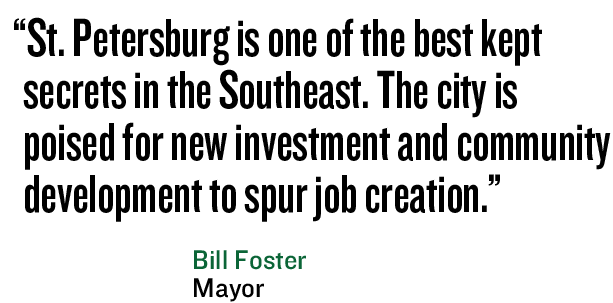 Over the past few decades, St. Petersburg’s median age has dropped from more than 50 to 42—one of the lowest on the west coast of Florida. Florida’s fourth-largest city, with a population of 250,000, St. Petersburg is described as having all the charm of a small town, but with the amenities of a large city. Illustrating its demographic evolution, St. Petersburg now hosts an international Grand Prix, a rock ‘n’ roll marathon, and triathlons. Yes, shuffleboard is still played, but, on Friday nights, it’s often accompanied by live music. “This isn’t your grandmother’s St. Petersburg anymore,” Mayor Bill Foster says.
Over the past few decades, St. Petersburg’s median age has dropped from more than 50 to 42—one of the lowest on the west coast of Florida. Florida’s fourth-largest city, with a population of 250,000, St. Petersburg is described as having all the charm of a small town, but with the amenities of a large city. Illustrating its demographic evolution, St. Petersburg now hosts an international Grand Prix, a rock ‘n’ roll marathon, and triathlons. Yes, shuffleboard is still played, but, on Friday nights, it’s often accompanied by live music. “This isn’t your grandmother’s St. Petersburg anymore,” Mayor Bill Foster says.
Surrounded by 260 miles of shoreline, as you’d expect from a peninsular city jutting out into Tampa Bay and the Gulf of Mexico, the city is ecologically inclined; it has been a Tree City for over 26 years, and, in 2007, it earned the first Green City accreditation in the state. Besides its environmental bent, the city works closely with the county school board to support its schools through programs such as Mayors, Mentors and More—an initiative that’s raised more than $10 million for college scholarships for kids at risk and attracted mentors and corporate partners for every one of its 46 public schools. On the higher-education front, St. Petersburg is served by three colleges in the local vicinity—the University of South Florida St. Petersburg, Eckerd College, and St. Petersburg College.
With more than 1,000 events a year, encompassing gallery and museum openings, and home to such sports teams as Major League Baseball’s Tampa Bay Rays, it’s evidently a comfortable place to live, but what kind of climate does it offer for businesses?
Fertile Ground
A KPMG audit this year identified St. Petersburg as one of the regions in the country with the lowest cost of doing business. The reasons for this are multifaceted: The cost of facilities and properties in the city have dropped to pre-2006 levels (the city has launched an online Blue Chip site to identify land opportunities for potential investors). And, depending on where you’re located and the type of company you are, there are also a plethora of credit, bonus, and tax-refund incentives available to businesses, at the city, county, and state level. While it’s home to numerous corporations that enjoy the state’s low corporate-tax-rate structure, St. Petersburg has also been recognized as a fertile business environment for small business, named the eighth Best Place for Small Business by Entrepreneur magazine and a Top 10 City for Small Business by Dun & Bradstreet. “St. Petersburg is one of the best kept secrets in the Southeast,” Foster says. “The city is poised for new investment and community development to spur job creation.”
According to Sophia Sorolis, manager of economic development for the city, the reason St. Petersburg is such a good location for smaller companies is similar to why it’s such a nice place to live: it has all the benefits of a larger metropolis coupled with a more personal way of doing business. “The city encourages the community and fellow businesses to court the small-business network, and it also has a business-assistance center that offers hands-on training and seminars for entrepreneurs and would-be entrepreneurs,” Sorolis says. As an added bonus, Florida has no personal income tax, and when companies relocate from areas with income tax, even if they pay their employees the same amount of money, Sorolis approximates a 10 percent increase of tax savings.
Merchant Hot Spots
The major business clusters present in St. Petersburg are financial services, medical technologies and life sciences, arts, culture, events and tourism, manufacturing, information technologies, and marine and environmental sciences. Following a statewide trend to bolster these sectors, St. Petersburg has numerous business initiatives in place to encourage growth in these particular areas. One example is the St. Petersburg Ocean Team, which hosted a global Coastal Cities Summit focusing on issues impacting coastal cities, in May 2012. “We are engaged in trying to build our clusters,” says Sorolis. “To provide them with information, events, and contacts to help them grow.”
The clusters are concentrated in the city’s two major business districts: downtown and Gateway. The former is home to a thriving community, and Sorolis says that companies find it easier to attract knowledge workers to that area because of its local color. “It’s part of the synergy of what makes downtown such a great business district,” she adds. More than 32,000 employees currently work downtown, with offices overlooking the bay and more than 100 downtown restaurants to choose from at lunch hour.
Gateway is also aptly named: only 10 minutes from two major airports (St. Petersburg-Clearwater and Tampa International Airport), and at the crossroads of interstate highways, Gateway positions businesses at the heart of the Tampa Bay region (while only 10 minutes north of downtown). Its well-developed office parks and corporate neighbors include the Home Shopping Network, Franklin Templeton, Bright House Networks, Catalina Marketing, Jabil, Halkey-Roberts, and Raymond James Financial.
Green City
The first city in the state to be designated as a “Green City” by the Florida Green Building Coalition, the designation is recognition of St. Petersburg’s long-term commitment to an ecologically sensitive agenda. The designation process took into account several factors. The first, the city’s reclaimed water system, is one of the largest in the country (despite a high-population density, the city is now using less water-per-capita than ever before). Other factors include an extensive system of 150 city parks over 2,500 acres; a City Trails network tallying more than 100 miles, the largest in the Southeast; the preservation of environmentally sensitive habitats; and the city’s 26 years as a member of the National Arbor Day Foundation’s Tree City USA, which has resulted in the planting of 18,000 trees since 2001. “St. Petersburg is a beautiful place, and its pristine environment is one of its best-selling features,” Foster says. “As the first Green City in Florida, we are committed to preserving this resource through the smart use of technology, sound business practice, and innovation.”
Of course, the process also reaps financial benefits for the city, such as the savings that will come through the replacement of all lighting in city-controlled parking garages, intersections, street lights, and even a solar-powered city park. And the city is encouraging its population toward electric vehicles, with the recent installation of 10 charging stations in the downtown area and the opening of the state’s first electric-vehicle dealership.
A Cohesive Business Community
St. Petersburg’s holistic program of economic-development initiatives, working in tandem with its many civic enterprises, has transformed this city into one of the most attractive business locales in the country. As Robert Danielson, the city’s communications manager, puts it, “People want to work where they can live, vacation, and raise a family. We’ve invested a lot into the community and its infrastructure; its art, entertainment, and recreation programs; and made it into a top-notch destination for businesses and their employees.”


